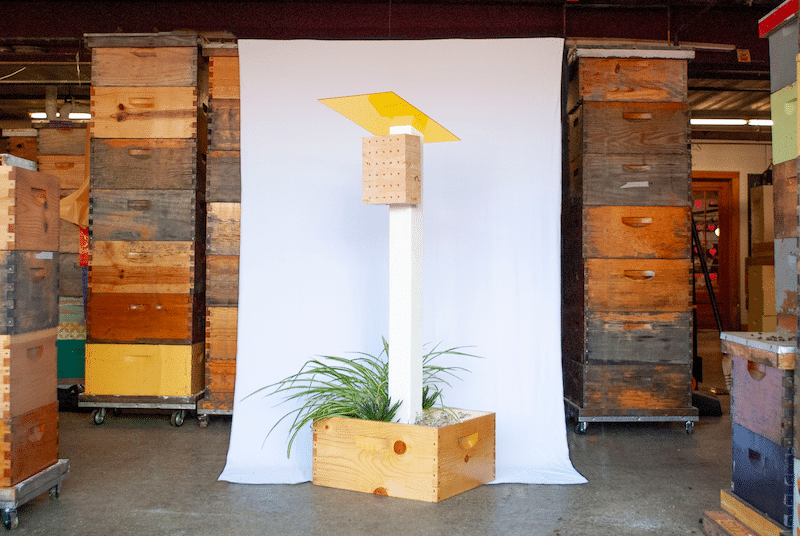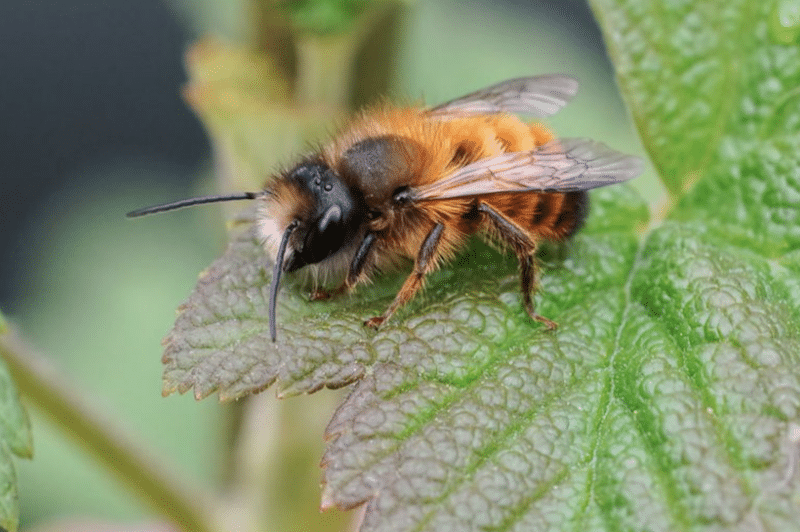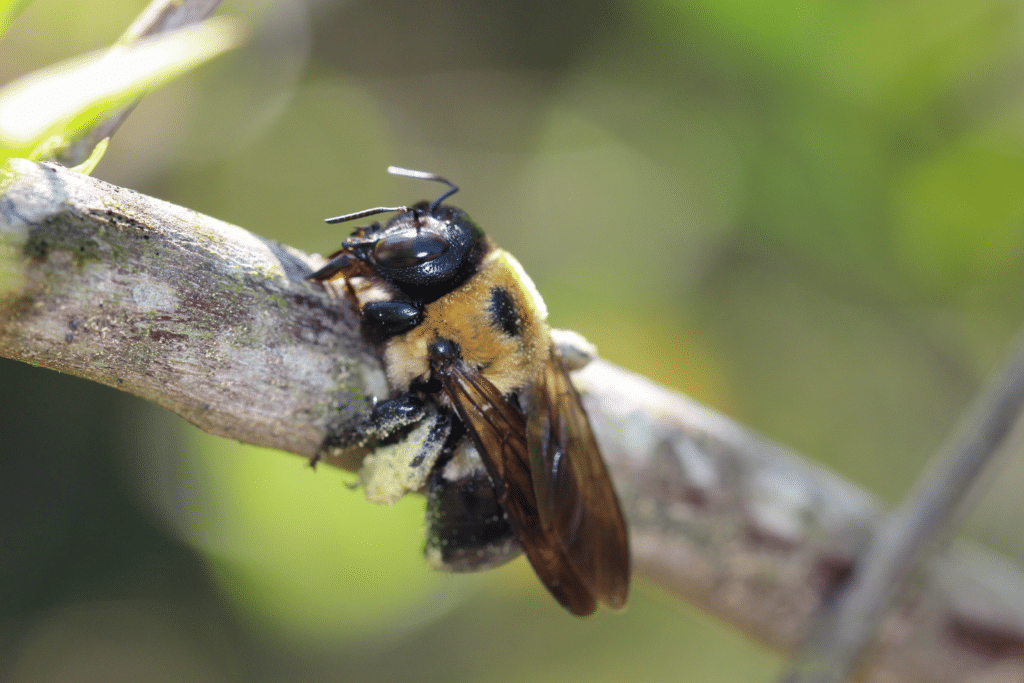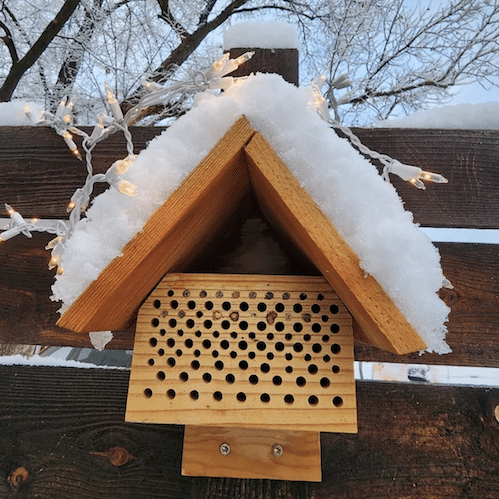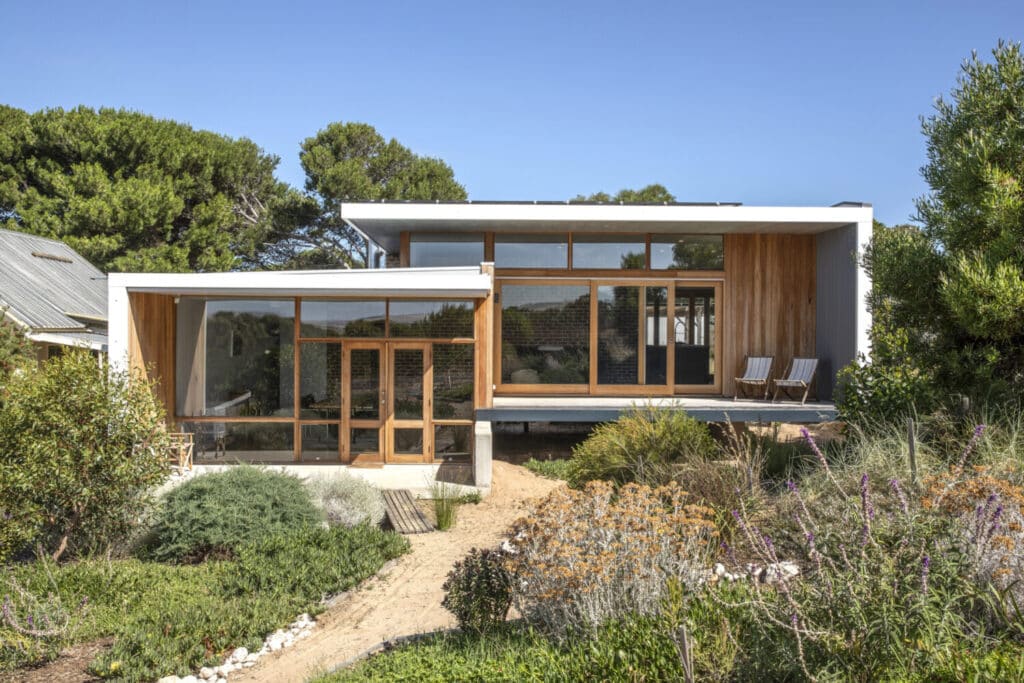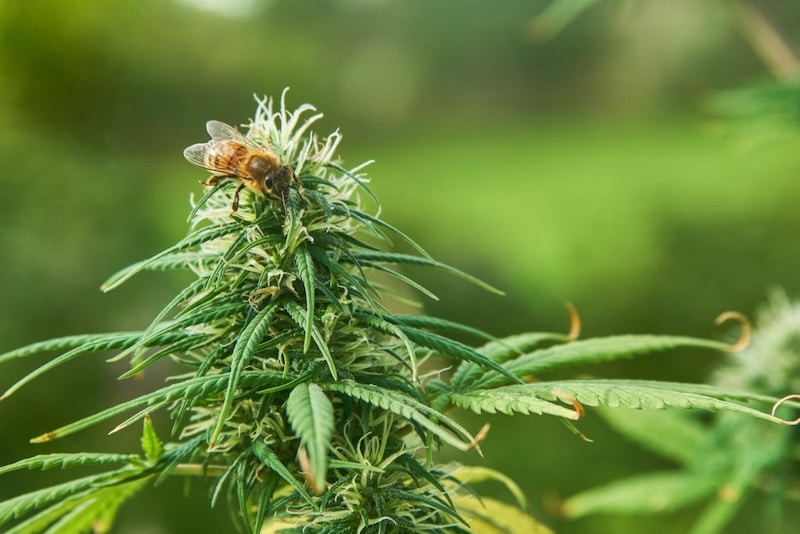Contents:
- What is a Bee Hotel?
- What Bees Use Bee Hotels?
- An Overview of Solitary Bees
- Benefits of a Bee Hotel
- How to Make a Bee Hotel
- Where to Put a Bee Hotel
- What to Plant Around Your Bee Hotel
- How to Tell If Your Bee Hotel Has Guests
- Bee Hotel Maintenance
- Protecting Bee Hotels From Weather
- Will Wasps Use a Bee Hotel?
- FAQs
What is a Bee Hotel?
A bee hotel, sometimes called a bee house, or a bee condo, is like an apartment complex constructed specifically for pollinators. In the wild, certain species of solitary bees and wasps seek out hollow reeds, holes in trees, or crevices in rocks to make their nest in. Bee hotels create a simulation of these environments by bundling together tubes of bamboo or reeds, or by drilling cylindrical holes in wood. In a bee hotel, each bee can nest in as many as a dozen tubes.
What Bees Use Bee Hotels?

Bee hotels are used by solitary pollinators. Unlike colonial bees and wasps, where thousands of insects work together to maintain a hive and provide food for a queen and the eggs she alone lays, solitary pollinators mate once, and then live entirely on their own. Without the benefit of a hive, they must find a safe place to lay their eggs. Bee hotels provide tubular environments that can be more weather resistant, structurally sounder, and safer places for pollinators than natural environments.
Because many solitary bees are small and have a limited flight range, Bee Hotels can provide much needed nesting environments that are close to sources for pollen and nectar.
An Overview of Solitary Bees
There are an estimated 20,000+ different bee species worldwide, and of these, about 250 are bumblebees, 500 to 600 are stingless bees, and seven are honey bees. Only a few, such as honey bees, form colonies; the vast majority of bee species—more than 19,000—are solitary.
About 4,000 bee species are native to North America. To learn more about the many different types of bees, read our blog Exploring Bee Species: 14 Types of bees and Bee Varieties.
The most common solitary bees found in North America are Mason, Leafcutter, and Carpenter Bees.
Mason Bees
Mason Bees are part of the genus Osmia. There are 140 species of Mason Bees native to North America. Slightly smaller than honey bees, female Mason Bees are characterized by an orange abdomen and feet, black fur on face and thorax, and brown hairs on the abdomen. Male Mason Bees differ only in having white fur on the face and a black abdomen with orange hairs.
After hatching, female Mason Bees live for 4-6 weeks. Male Mason Bees mate soon after emerging from their nests and die shortly after mating. During their brief lives, female Mason Bees tend to pollinate fruit and nut trees. Mason Bees lay their eggs in pre-existing tunnels (created naturally, by beetles, or by humans). According to The Ecological Landscape Alliance, Mason Bees prefer holes that are 5/16” in diameter.
Mason Bees may lay eggs in as many as seven different adjoining tubes, with the female eggs in the rear where they will be better protected from predators, and male eggs in the front. After the eggs are laid and pollen and nectar are stored for them to feed on, the tubes are sealed up with mud, which is where Mason Bees get their name.
To learn more about Mason Bees, read our blog Everything You Need to Know about the Mason Bee: Types, Species and 10 Amazing Facts.
Leafcutter Bees
Leafcutter Bees are part of the genus Megachile. There are 242 species of Leafcutter Bees native to North America. Leafcutter Bees are slightly larger than Mason Bees, and about the same size as Honey Bees. They are dark, with bands of white hairs on their abdomens.
Leafcutter bees are important cultivators of late season fruits and vegetables, including commercial crops such as alfalfa, blueberries and carrots. Leafcutter Bees either build their nests in existing cavities, such as beetle tunnels or reeds, or excavate tunnels from soft rotting wood.
Typically, a Leafcutter female will create a dozen nesting cells, which she will line with circles of leaves she has carefully cut from plants, which is where Leafcutter Bees get their name. Males hatch first, and mate with females as soon as they emerge. They die shortly after mating. Females can live for two months or more and begin to create their nesting cells late spring or early summer.
Like Mason Bees, Leafcutters put the female eggs in the back of their nests, and male eggs in front. This allows the male Leafcutters to exit first and provides extra protection for female eggs and larvae from predators. Once all her eggs are laid, the female seals up the nesting tubes with a solution of chewed leaves and saliva, which hardens quickly and protects the eggs and larvae from cold, rain and predators. To learn more about the Leafcutter Bee, read our blog Everything You Need to Know about the Leafcutter Bee.
Carpenter Bees
Carpenter bees, along with Bumblebees, are the largest bees in North America. Females are black with hairless abdomens, while males are orange and black striped. Like Bumblebees, Carpenter Bees are buzz pollinators, meaning they vibrate their bodies to shake free pollen from flowers. Carpenter Bees pollinate a wide-variety of plants.
Female Carpenter Bees chew perfectly round tunnels into hard wood, deposit a ball of bee bread for their larvae to feed on, lay their eggs on top, and then seal the tunnel with sawdust from their tunnel excavation. Carpenter Bees live for about one year. To learn more about Carpenter Bees, read our blog Everything You Need to Know about the Carpenter Bee.
Benefits of a Bee Hotel
Native pollinators, just like honey bees, are threatened by habitat loss. Installing a bee hotel is an active and tangible way to support the native pollinator population, which is crucial for maintaining biodiversity and healthy ecosystems.
Additionally, native bees are excellent pollinators. Mason bees, for example, are fuzzier than honey bees; consequently, they pick up and drop off more pollen as they fly from flower to flower. They’re also much less efficient than honey bees at carrying their pollen loads. This means they have to make more trips, more frequently, in order to forage a sufficient amount of pollen!
How to Make a Bee Hotel
Bee hotels are simple to make, require only a few materials and tools, and can be built in less than 90 minutes. There are two basic types of bee hotel: 1) those built from a collection of hollow reeds and stems, such as bamboo; and 2) those built from blocks of wood with holes drilled into them. You can follow either approach or combine the two and build a nesting place for hundreds of solitary native bees.
Here are the steps to build each type of bee hotel:
Hollow-Reed 18” X 12” Bee Hotels

- Gather materials: You’ll need about six feet of 8” pine or spruce and eight 1 3/4“ wood screws to make the sides, top and bottom of your bee hotel, and several dozen pieces of yard-long bamboo or hollow reeds of varying thicknesses (1/8” to 1/2”) for the nesting tubes that will go into it.
- To make the frame of your bee hotel, cut two 12” pieces of wood off your board—these will be the top and bottom of your bee hotel, then cut two 24” pieces—these will be its sides.
- Drill holes about 1” down and 1/2” in from the side of the bottom board; drill all the way through the board; repeat in all four corners; do the same to the top board.
- Set the two sides of the frame on their ends on a work bench and stand the bottom board against them so that it exactly covers the two side boards. Place the screws in the holes, and while holding the side and bottom boards together, tighten each screw until it is flush—this will lock the bottom to the sides.
- Flip the three boards so that the bottom is on the bench and the sides are standing up; place the top board across the sides, insert the screws, and tighten with a screwdriver until flush. This will complete the frame of your Bee Hotel.
- Cut your hollow bamboo/reeds into 8” segments and stack them in the frame of your Bee Hotel. When you’ve stacked the frame full, to stabilize the reeds, fill some of the gaps with reeds that are slightly larger than the gaps—this will push them together and lock them into place.
Drilled Wood 18” X 24” Bee Hotels

- Gather materials: You’ll need about seven feet of 8” pine or spruce and eight 1 3/4“ wood screws to make the sides, top and bottom of your bee hotel, and 10-15 short logs or blocks of untreated wood about 3-4” across, where you’ll drill holes for nesting tubes.
- To make the frame of your Bee Hotel, cut two 12” pieces of wood off your board—these will be the top and bottom of your bee hotel, then cut two 24” pieces—these will be its sides.
- Drill holes about 1” down and 1/2” in from the side of the bottom board; drill all the way through the board; repeat in all four corners; do the same to the top board.
- Set the two sides of the frame on their ends on a work bench and stand the bottom board against them so that it exactly covers the two side boards. Place the screws in the holes, and while holding the side and bottom boards together, tighten each screw until it is flush—this will lock the bottom to the sides.
- Flip the three boards so that the bottom is on the bench and the sides are standing up; place the top board across the sides, insert the screws, and tighten with a screwdriver until flush. This will complete the frame of your bee hotel.
- Cut your logs or blocks of wood into 8” segments and stack them in the frame of your bee hotel with the ends facing out.
- When the bee hotel is fully stacked with short log pieces or blocks of wood, drill holes of varying diameters about 4-5” deep into each, about an inch apart. When you’ve finished drilling, make sure all the openings are smooth and splinter-free—bees won’t use tubes with rough entrances. If needed, use a countersink drill to smooth the opening area, or use sandpaper to smooth the opening.
If you don’t have the time or the means to build your own, there are plenty of bee hotels available for purchase. For Best Bees beekeeping clients, bee hotels are available as an additional service offering. Our beekeepers, in addition to caring for and collecting data from your honey bee hives, will monitor the bee hotel and collect data to track its activity and occupancy. Your bee hotel becomes an important asset for our research on native bee health and population levels.
Where to Put a Bee Hotel
You can attach your bee hotel to a fence or the side of a building or sit in on a low wall or platform. Face it to the south, in a place where it will get sun most of the day—as cold-blooded creatures, bees and their larvae need warmth from the sun. Wherever you put it, make sure that it’s at least three feet off the ground.
Once you have it installed, secure it so it won’t blow around in the wind, or topple over in a storm. Check the area around it to make sure it’s not obscured by garden plants or shrubs—these can block the sun and prevent bees from finding it.
What to Plant Around Your Bee Hotel

Plant a variety of native flowering plants near your bee hotel. The Xerces Society has a library of pollinator-friendly native plant lists; this is a good resource to start with.
You may find that your bee hotel attracts a variety of different solitary bees, with different approaches to nectar and pollen gathering. Planting many different native species will assure that you’re providing some ready forage for all kinds of bees.
Bee species can vary in terms of when they emerge—some in late winter, others in late spring and early summer. To provide sustenance for different species, make sure you have species that bloom throughout the season.
Avoid double flowering hybrids, as the mass of petals in these varieties can block bees from gaining access to pollen and nectar. Don’t plant invasive non-native species, as these have a tendency to outcompete other plants for moisture, sunlight, nutrients, and space. Once an invasive species establishes dominance, it destroys the biodiversity of an area and is typically very difficult to remove.
There are so many wonderful plants to choose from that will contribute to a thriving ecosystem. Make sure you know your area’s grow zone so you can identify which plants will grow best in your garden! For some inspiration, check out our blog 6 Awesome Plant Types That Will Attract Bees To Your Garden.
How to Tell If Your Bee Hotel is Hosting Guests

In mid to late summer, if you see bees frequently going in and out of the tubes in your bee hotel, there’s a good chance that they will lay eggs there. The most reliable indicator of nesting bees will come in late summer and early fall. This is when the nesting bees will seal up the tubes where they’ve laid their eggs. If you see mud, leaf or sawdust plugs filling some of the tube ends, you’re hosting guests in your bee hotel!
Bee Hotel Maintenance
Bee hotels require periodic maintenance. By mid-summer, all new adult bees from the previous season will have emerged; any tubes that are still walled up should be opened and cleaned out or removed, as dead larvae can spread disease.
In autumn, identify any cells that have been occupied by parasitic flies such as Cacoxenus indigator, as these will prey on bee larvae. You can spot these infected cells because they will have a small opening in the front plug, where the fly larvae have entered the bee nests.
Every two years, replace blocks of wood and old reeds. Have new reads or blocks of wood ready to go, and remove all old, unused wood and reeds in early spring; replace used wood and reeds around mid-summer.
Some birds, such as woodpeckers, will feed on bee eggs and larvae. If you see them pecking at your bee hotels, mold a screen of chicken wire mesh about an inch out from the front of your hotel—this will prevent them from eating the eggs and larvae.
If you bring your bee hotel into an unheated porch or shed for the winter, it may fall prey to spiders and other insects who like to feast on bee larvae. You can keep insect predators out by covering your Bee Hotel in a breathable fabric . Just remember to remove the covering in late winter, so that new adults can emerge, mate and begin foraging.
Protecting Bee Hotels from Weather
If your bee hotel is exposed to the elements, it may receive too much precipitation in the winter. This can dissolve the mud seals on occupied tubes, and promote rot and fungus that can kill larval bees. To protect your bee hotel from excessive moisture in cold weather, bring it into an unheated open porch or shed during the worst of the winter season. Remember to protect it from unwelcome intruders by covering it with a breathable cloth. In the late winter, once temperatures are milder you can return it to its sunny spot in your yard. To learn more about how to maintain and protect your Bee Hotel, read this informative blog: How to Make and Manage a Bee Hotel.
Will Wasps Use a Bee Hotel?
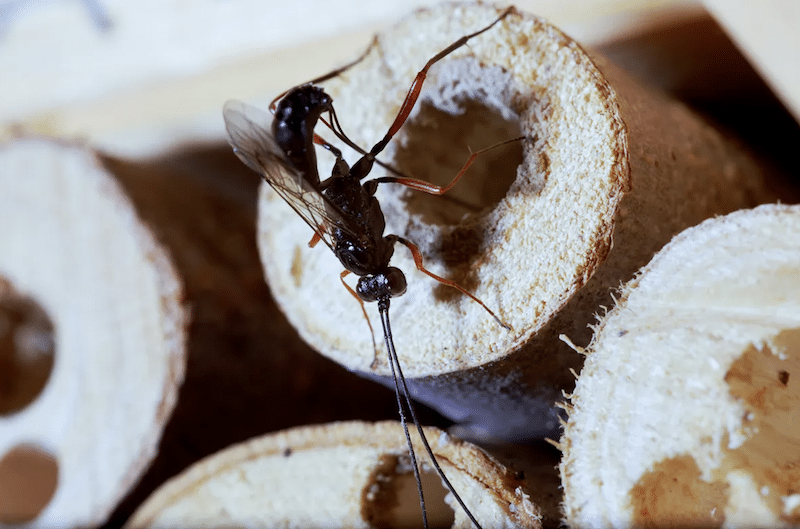
Some solitary wasps, such as red and black Mason Wasps, can be valuable pollinators. Their nesting habits are similar to solitary bees—they like to lay their eggs in cavities, and so will be attracted to Bee Hotels. These wasps are vegetarians—they gather pollen and nectar like bees and pose no threat to bees;they also are unlikely to sting humans!
There are, though, other types of wasps, such as Chalcids, that prey on solitary bee larvae. These wasps puncture the seal on bee hotel nest tubes and deposit their eggs in the bee’s nest. When the wasp eggs hatch, they feed on the bee larvae, eventually killing them.
To protect against predatory wasps, close the back of your Bee Hotel with a wooden board, and wrap your Bee Hotel in a fine gauze in early autumn. You can learn more about predatory wasps in Parasites and Diseases of Mason Bees written by our friends at Crown Bees, who specialize in bees and supplies for cavity-nesting solitary bees.
FAQs
Q: What types of pollinators use Bee Hotels?
A: Solitary bees, such as Mason, Leafcutter and Carpenter Bees, and occasionally solitary and wasps, such as red and black Mason Wasps.
Q: Are Bee Hotels hard to build?
A: No—a modest 18” X 12’” or 18” X 24” bee hotel requires only minimal carpentry skills, and could be completed in less than 90 minutes.
Q: What do I need to build my own Bee Hotel?
A: You’ll need about 7-8’ of 8” pine or spruce board, 8 wood 1 ¾ ” woodscrews, and either a dozen short logs or blocks of wood, or a few dozen hollow reeds or bamboo canes of varying dimensions. You’ll also need a saw, a screwdriver and if you’re drilling holes in blocks of wood rather than using hollow reeds.
Q: Where should I put my Bee Hotel?
A: You can put your bee hotel on a building or fence or set it on a wall or platform. It should be at least three feet off the ground, well secured, facing south, in a sunny location.
Q: Will my Bee Hotel require any maintenance?
A: You should replace all blocks of wood and hollow reeds at least every two years, and any that have been used as nests in mid-summer, before new bees begin nesting.
Q: Do I need to protect my Bee Hotel in the winter?
A: If you live in an area where there is frequent rain or snow, you can bring your bee hotel into an unheated shed or open porch from November through mid-February to avoid water damage to nests and rot and fungus in the wood blocks and reeds.
Q: Do I need to protect my Bee Hotel from parasites and predators?
A: If birds are eating the larvae in your bee hotel, you can protect them by molding chicken wire about 1” out from the face of the hotel. You can protect from predatory flies, spiders, and wasps by covering the front of the hotel with a fine gauze or cloth from November through mid-February.


